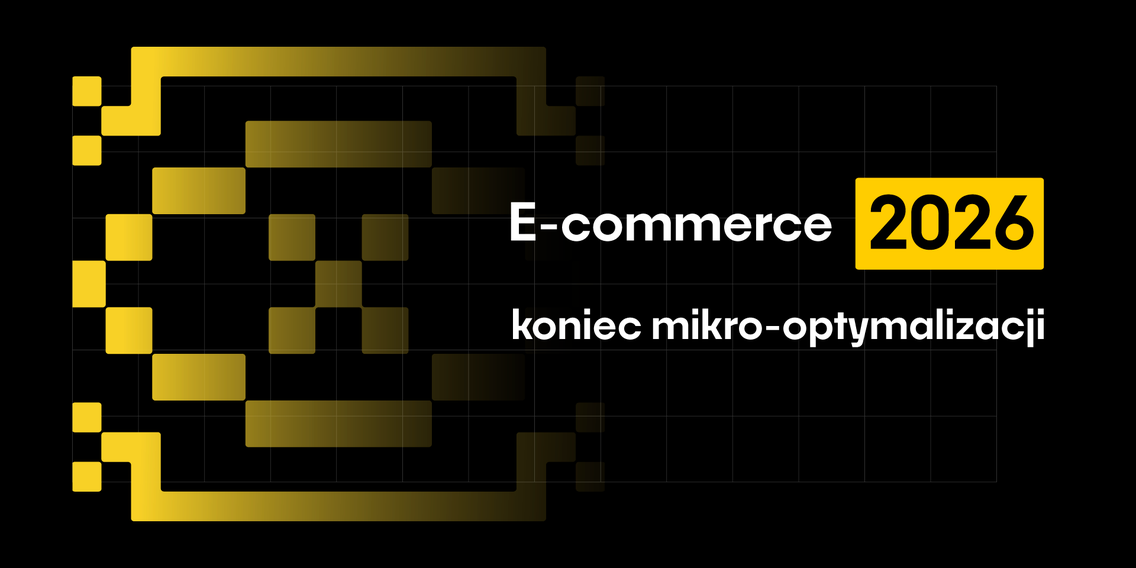8 min
November 20, 2025
E-commerce 2026: The End of Micro-Optimization
The last decade in e-commerce was the era of micro-optimization. We focused on battling high cart abandonment rates (which average over 70%), simplifying forms, and implementing chatbots. These actions are still important, but no longer sufficient.
The market is entering a phase of tectonic shifts that concern not just the frontend layer, but the very foundation of the architecture. Success now depends on agility and risk management, not just low price. The entire online retail industry must transform.
Decision-makers must redesign the operational model. The new strategy is not about minimizing purchase disruptions but about managing systemic non-compliance and the growing TCO (Total Cost of Ownership) resulting from global fragmentation. This is a new approach to strategic marketing.
Below, we analyze the key, irreversible trends that will define e-commerce in 2026 and necessitate an urgent strategy revision.

Listen to the audio version of this article.
1. Digital Fragmentation: The "Splinternet" Tax and Rising TCO
The global Internet as we know it is ceasing to exist. The political drive for digital sovereignty (EU, China, USA) is leading to the emergence of the "Splinternet", a separate, regulated digital ecosystems.
The Risk of Non-Compliance: The Price for Market Access
Previously, we aimed for global architectural standardization. However, this model is obsolete. Divergent regulations regarding Data Localization, personal data, or even AI ethics mean that e-commerce architecture must be adapted to each region. Store owners must actively assess whether potential revenue justifies the cost of architectural adaptation to local regulations.
Rising Infrastructure TCO
Data localization mandates force a shift away from optimization towards redundancy. TCO must now include the more expensive maintenance of multi-regional data infrastructure and systems that comply with requirements like the EU-US Data Privacy Framework. This directly impacts the company's budget allocated for IT infrastructure.
Conclusion: Global e-commerce cannot rely on a single, central architecture. In 2026, the business model will have to account for geo-specific redundancy.
2. AI-Native Architecture: From Automation to Autonomous Compliance
AI is no longer an add-on (a chatbot) but is becoming the heart of systems, while simultaneously generating new, serious legal risks. This is a revolution in the approach to technology.
Agentic Commerce: The Future of Autonomous Agents
Have you heard the term "Agentic AI"? This is Artificial Intelligence that operates autonomously and purposefully, changing the e-commerce operational model. AI agents will be able to autonomously optimize the supply chain, manage returns, or precisely predict demand.
Such autonomy can increase operational ROI by over 25%, but it carries enormous ethical and legal risk. If the AI autonomously sets dynamic prices or makes decisions about rejecting a transaction, its actions must be constantly monitored.
Generative Search Engines (e.g., ChatGPT Atlas) and Product Discovery
The emergence of advanced generative search engines, such as ChatGPT Atlas, fundamentally redefines the product discovery path. AI no longer returns a list of links (like traditional Google) but a final, verified product recommendation, and in the future, may even execute the final purchase for the customer.
New Imperative: AIO (AI Optimization): This trend means that traditional SEO is losing relevance, and profit growth depends on the quality of data and the API architecture of your store. For your products to appear in recommendations, AI Optimization (AIO) is necessary—ensuring that the AI model has access to clean, reliable, and comprehensive information. Stores based on flexible architecture (Headless/API-first) have an advantage here.
New Design Requirements: Regulation as a Constraint
The entry into force of regulations like the EU AI Act is globally changing system design. Legal compliance is becoming an architectural requirement:
Mandatory Transparency: Systems must disclose how algorithms processed data (e.g., in product recommendations).
Human Oversight: High-risk applications (e.g., anti-fraud systems) must have built-in mechanisms enabling human intervention.
Conclusion: Investments in AI must go hand-in-hand with investment in Data Governance and AI auditing systems. Companies should prioritize training talent that combines deep engineering knowledge with legal competencies.
3. Dominance of First-Party Data: New Currency and Acquisition Costs
The sunsetting of Third-Party Cookies after 2025 forces companies to fundamentally transform their marketing architecture.
The End of Retargeting and Rising Costs (CAC)
The disappearance of cookies will limit the ability to track consumers, hitting e-commerce based on targeted retargeting. The loss of precise behavioral data will increase CAC (Customer Acquisition Cost) because campaigns will become less effective. The priority is now customer retention within the site, which increases the strategic weight of optimizing the checkout itself and boosting sales.
Building a First-Party Data Vault
First-Party Data (collected directly from the customer) becomes the only reliable source of valuable information. Companies that effectively use this strategy report 8x higher ROI and 25% lower CAC.
Conclusion: Data management is shifting from a marketing expenditure to a key element of Enterprise Risk Management. Investing in a First-Party Data architecture is an investment in GDPR compliance and a lasting competitive advantage.
4. Green IT: Sustainability as a TCO Criterion
Sustainability (ESG) is evolving from a voluntary CSR goal into a mandatory architectural requirement, affecting TCO and vendor selection.
Ecological Vendor Filter and TCO
The traditional TCO model must be expanded to include environmental responsibility.
Vendor Compliance Audit: Technology partners must meet requirements regarding minimum product lifespan and the use of renewable energy in factories.
Operational Cost Optimization: Choosing green hosting (powered by renewable energy) is, in the long term, a reduction of operational costs in an unstable energy price environment.
Digital Supply Chain and Brand Image
Presenting clear information about the environmental aspects of a product (Green Transparency) translates into conversion. Moreover, choosing ecological IT solutions (green hosting) is becoming an Employer Branding tool, which helps in retaining highly qualified talent.
Conclusion: IT architecture must be ready to manage and report environmental data.
5. Real-Time Hyper-Personalization
Hyper-personalization has evolved: customers no longer expect recommendations based on last week's purchase history but on current context and intent (e.g., weather, location, time spent on the page). Monolithic systems are unable to process and deliver personalized content at the speed required by real-time (below 100 ms). API-First Commerce integration becomes a necessity to connect with external, dedicated personalization engines (e.g., CDP) and instantly deliver dynamic prices, content, and recommendations to the frontend. This agility, based on Edge Computing and First-Party Data, is key to raising AOV (Average Order Value) and LTV (Lifetime Value).
Conclusion: To achieve real-time hyper-personalization, e-commerce architecture must be modular and API-centric. Merely possessing the data is insufficient—the key is the ability to instantly activate and deliver it at the network edge.
6. Growing Importance of "Composable" Experiences and Speed (Performance as a Feature)
In the era of AI-Native Commerce, where customers have access to instantaneous answers and recommendations (e.g., via ChatGPT Atlas), loading speed (Core Web Vitals) ceases to be an optimization and becomes a critical product feature. Customers abandon pages that take longer than 3 seconds to load. Traditional, monolithic platforms are rarely able to meet the Core Web Vitals requirements. In response, decision-makers are moving away from buying "all-in-one" (Monolith) towards the philosophy of Composable Commerce—choosing best-of-breed components (PIM, CMS, Checkout, Search) and connecting them via API.
Conclusion: The future of digital commerce belongs to Composable Commerce. The agility of the modular approach and the near-instantaneous loading of the frontend (achieved through Headless) are now a market requirement that directly translates into a better conversion rate and lower TCO in the long term.
7. Rise of Social Commerce: From Inspiration to Purchase in One Channel
This is one of the key trends that will define the coming years for online sales. The evolution of social media is accelerating, and platforms such as TikTok, for example, are no longer just social channels but are becoming fully-fledged purchasing ecosystems. This also applies to Instagram, as well as every other marketplace platform and application that allows for immediate transaction finalization outside of the traditional online store.
It's worth bearing this in mind because by building direct relationships, it significantly improves the customer experience and delivers valuable data (including purchase history)—crucial in the context of the vanishing Third-Party Cookies.
Architectural and Analytical Requirements: Success in Social Commerce, supported by AI in e-commerce, depends on rapid product data integration (PIM) and effective analysis of user behavior. This, in turn, requires an architecture that enables the immediate synchronization of product data and prices.
Conclusion: To fully utilize the potential of Social Commerce, the integration of platforms with your e-commerce system is key. Loyalty built in these channels is becoming a new pillar of online sales, requiring detailed analysis of purchase paths and investment in the customer experience outside of the traditional online store.
Summary: Architecture 2026 – Agility and Compliance
The forecasts are clear: the era of simple solutions is over. The future of digital commerce requires platform managers to think at the architectural level, not just the marketing level.
Three Key Imperatives:
Managing Regulatory Risk: Acceptance of higher TCO resulting from geo-specific redundancy and investment in auditable AI systems (EU AI Act).
Establishing Data Ownership: Investment in architecture that independently collects and activates First-Party Data.
Choosing Strategic Partners: Replacing vendors based on the lowest price with partners offering contractual guarantees and certified compliance with Green IT principles.
As Beecommerce, we specialize in Headless architectures and advanced cloud solutions that enable this essential agility. So don't wait until TCO costs and regulatory risks block you. Order our strategic architecture audit to check how ready your current platform is for the challenges of 2026. Contact us today to schedule an initial consultation!




